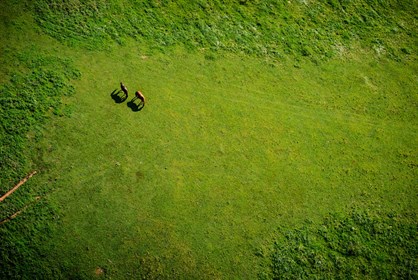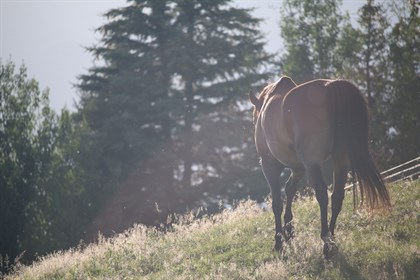
This article has appeared previously with Equestrian Life. To see what's in the latest free, digital issue, please click here.
Good pasture management is an important part of horse ownership.
Pasture masterclass
By Chloe Chadwick
Good soil and pasture are often overlooked when choosing a property. Dr Mariette van den Berg, a specialist in integrated equine nutrition, horse property design and pasture management, tells how to get the best pasture for our horses.
Equestrian Life: How important is soil quality and pasture when choosing an equestrian property?
Dr Mariette van den Berg: Of course, location is everything. Pasture and soil quality are not at the top of the equation when choosing a property. A lot of people will initially look at the aesthetics: they will look at the view, the neighbours and probably at how convenient the property is to work. It is later that people will look at what is going on with soil and pasture.
Horse owners are often more focused on what infrastructure is on the land - like fencing, shelters, stables and arenas - and not a lot will look at the soil or at the pasture as a basis to locate, or whether the property needs a lot of development before horses can graze. Can we improve the pasture? Yes, but it is always handy if you have a nice starting point. When examining soil quality on a property we generally grade it on an A B C D scale. A is where you have good ground cover of high quality pasture, and it’s long established. B: It’s a little bit patchy, not as much cover; and when we get to C or D, you get a lot of weeds and exposed soil. It is much harder from D and C to get to A and B. So, getting back to that topsoil quality with a lot of grass cover will usually need some investment and either mechanical or biological management.
Definitely looking at soil quality when choosing a property is the wise thing to do. However, sometimes you find that perfect location with beautiful views but with soil that is really compacted, and not a lot of ground cover or a lot of weed. Improving this property is still possible. So I would say, definitely take into consideration that although we can easily destroy soil, we can also easily develop it.
EQL: How much can be improved? Or am I stuck with what my property already has?
MB: There is a lot we can do. First, look at the compaction. Compaction is one of the biggest problems -- overgrazing and compaction were the two major problems that came out of a survey I conducted when I looked at behaviours of horses in pastures -- and is also one of the problems that horse owners raise most frequently.
When you get beyond a certain level of compaction, no plant species can really grow in the soil because no water or oxygen can get in, so you cannot get an aerobic situation. This is hard to undo without mechanical interference. So we employ a ploughing system, and in my consulting I talk a lot about the Keyline concept, where we work with natural patterns to get into the deeper layers, really trying to open up the soil. This procedure prevents the erosion that can occur with other techniques.
On top of using a Keyline ploughing system, you can then source some of the seeds you wish to stock your pasture with. Initially you can also use nitrogen-rich additives such as manure and compost to get things started.
In the beginning we may have to be less discriminating towards weeds and plants whilst you build the soil. Once you have more oxygen and decompaction, you will notice that soil microbes and all kinds of native species will come back. Then you can look at the actual sowing process. Initially using what we call pioneer species, along with compost, is a good basic way to return minerals back to the soil. If you don't have organic material, you cannot build rich soil.
Your location and your climate will dictate the type of pasture you can grow.
EQL: Should I be using minerals or fertilisers on my pasture?
MB: Having an anaerobic situation in pastures can potentially be a breeding ground for bad microbes and fungi where we can get respiratory problems and such, particularly in young horses. Besides mechanical interference, we have natural minerals or other fertilisers that we can add to the soil. To speed up the growth and decomposition process, we need to add at least a fertiliser and essential minerals, such as lime if there is a pH problem. I advise getting the soil tested for acidity, as well as for the possible addition of nitrogen and potassium. However, another option, and the way I often suggest, is the natural way, using compost. Using your horses’ manure and garden scraps, you can combine this with mulching, or even a bit of old hay or straw, along with water and fertiliser, to really speed up that breaking-down and add minerals into the pasture.
EQL: Should paddocks be sown, and what mix of pasture should I sow for optimum equine nutrition?
MB: Once you have dealt with decompacting and adding more organic matter, then you can be more selective. Your location and your climate will dictate what you can grow. In Australia we see that in Queensland, for example, different grasses will adapt between the warm and hot climate. In Victoria and Tasmania we see a different range of native species. Ideally you would like to have a mixture of different species that flourish in either cold and dry or humid conditions to encourage a more distributive growth pattern.
I always say, build soil and see what happens before you sow, because often a seed bank is already available, and if you create the right conditions you may already get the right selection for your area. If you are a little bit more specific about what you want - for example, if you want low-sugar pastures - then you need to look into these specialised species.
There are a lot of seed companies that offer a mix of pure native or of both native and improved pasture. You want to work locally, so look at a nearby supplier and ask them if they have a mixture for horses. Ask what is in it to really evaluate if it fits you, your horses and your conditions.
EQL: What should I do to improve pasture going into winter? And when is the best time to work the paddocks?
MB: Ideally, you would like to work on your pastures all-year round. However, when you get into the non-growing season there is not much you can do except clearing up and making sure you have a proper rotation system.
Just before and during spring is the time to look into making sure you have the right nutrition. Before the rain sets in, have your compost spread or your fertiliser spread ready, adding minerals if you have to, so that you take advantage of the rain and temperature that assists with growth.
Things that you can do just before winter are making sure that if you are moving your horses whilst grazing, or that you have paddocks where you can rotate animals, the pasture is getting sufficient time to recover, making sure you are not overgrazing.
EQL: How should I rotate my horses on pasture to optimise nutrition? And how big should paddocks be?
MB: When we look at rotation it's not the horse that dictates it. Yes, it is based on a per kilo basis on what your horse needs and then multiply that by the number you are grazing, but you really need to look at the pasture availability: We calculate it as dry pasture per hectare. You look at how long your grass is - there are different tables online that can help you - and you can then on a per hectare basis calculate how much potential dry matter you have available. You divide it by the number of horses, and then also calculate it based on the food requirements of the horses. Nutritionists advise that 2% of the body weight needs to be offered in dry matter. This is just for a non-working horse, but if you have a horse in work then you go up the scale. Breeding, lactating, and growing horses also differ, so it really depends on the class of horse how much availability you need to have.
EQL: How much should I take the quality of pasture into account when designing my horses’ diets?
MB: Again this links back to how much pasture availability you have and how many horses. Typically, a lot of people in Australia will supplement, not necessarily only because they don't have enough availability, it is also a bit of an industry-accepted practice. A lot of people like to have that contact with their horse when they feed, so they supplement whether there is availability or not. And also, of course, you generally want to add vitamins and minerals, protein or carbohydrates to balance a horse’s diet for growing or for performance.
On most properties we deal with, there is not enough pasture, so you need to balance that with fibre. You definitely need to look at the basics: Do you provide enough roughage in your pasture? First, look at what the pasture provides, then look at your roughage, and then look at the additional requirements based on what your horse does.
Through her research and experience in pasture, property and nutrition consultation, Dr Mariette van den Berg holds regular clinics and talks. Keep an eye out for her upcoming courses and online learning platforms, with updates regularly on mbequineservices.com.
READ THE LATEST NEWS ARTICLES HERE
https://www.equestrianlife.com.au/articles/Pasture-Master-Class


